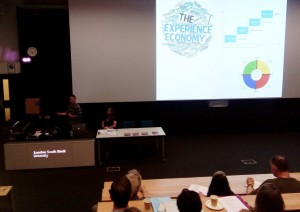Three-D Issue 27: Post-Screen Cultures/Practices
The 2016 MeCCSA Practice Network / Journal of Media Practice symposium, Post-Screen Cultures/Practices was held at London South Bank University on 10 June. The day focussed on practice-based research and featured papers, presentations of practice, and film screenings.
 The symposium sought to explore how, with the proliferation of mobile devices, the screen is an ever-more pervasive, personal and immersive presence in everyday life. According to Ofcom, the tablet has become the must-have device, with over half of UK households (54%) now owning one. Raised as ‘screenagers’, one in ten (11%) 3-4 year olds now have their own tablet as a pacifier, educational aid and entertainer. Our urban spaces offer up new forms of interaction as the numbers of screens multiply. Via the screen we navigate an evolving media and cultural landscape that is increasingly interactive, intuitive and always on.
The symposium sought to explore how, with the proliferation of mobile devices, the screen is an ever-more pervasive, personal and immersive presence in everyday life. According to Ofcom, the tablet has become the must-have device, with over half of UK households (54%) now owning one. Raised as ‘screenagers’, one in ten (11%) 3-4 year olds now have their own tablet as a pacifier, educational aid and entertainer. Our urban spaces offer up new forms of interaction as the numbers of screens multiply. Via the screen we navigate an evolving media and cultural landscape that is increasingly interactive, intuitive and always on.
The theme attracted international interest, with papers submitted from colleagues in Singapore, Portugal, Greece, Holland and the United States, as well as from universities across the UK. Speakers explored the material as well as the digital character of contemporary screen cultures, raising questions about the nature of the interface and the attempted commodification of audiences.
 The symposium featured six parallel sessions and a plenary with Peter Woodbridge (Manchester School of Art) and Jill Daniels (University of East London), so it would be impossible to do justice to the wide variety of interesting presentations in this brief summary. Nevertheless, a number of key themes did emerge across the day. Firstly, it seemed that there has been a rise in the importance of audience/user studies. A panel on ‘Screen-Mediated Audience Interactions’, for example, explored different approaches to engaging audiences using screen-based technologies: through relational aesthetics, audience participation and heightened simulacra.
The symposium featured six parallel sessions and a plenary with Peter Woodbridge (Manchester School of Art) and Jill Daniels (University of East London), so it would be impossible to do justice to the wide variety of interesting presentations in this brief summary. Nevertheless, a number of key themes did emerge across the day. Firstly, it seemed that there has been a rise in the importance of audience/user studies. A panel on ‘Screen-Mediated Audience Interactions’, for example, explored different approaches to engaging audiences using screen-based technologies: through relational aesthetics, audience participation and heightened simulacra.
 A second important theme was the blending and blurring of the material and the digital. ‘What was screen is becoming material’, said one presenter, referring to the range of technologies – virtual and augmented reality, computer-mediated sensors, the Internet of Things, etc. – that offer the possibility to embed digital encounters within the physical world. Overall, perhaps the most striking thing to emerge was a feeling that the current moment is in some ways similar to the earliest days of cinema – a time of vibrant experimentation, in which, while rejecting the fetishisation of technology, artists and media practitioners are embracing the chance to explore the new possibilities on offer.
A second important theme was the blending and blurring of the material and the digital. ‘What was screen is becoming material’, said one presenter, referring to the range of technologies – virtual and augmented reality, computer-mediated sensors, the Internet of Things, etc. – that offer the possibility to embed digital encounters within the physical world. Overall, perhaps the most striking thing to emerge was a feeling that the current moment is in some ways similar to the earliest days of cinema – a time of vibrant experimentation, in which, while rejecting the fetishisation of technology, artists and media practitioners are embracing the chance to explore the new possibilities on offer.
In ‘Future Screens’, Jill Daniels focused on experimental film practice, reflecting on our changing relationship to screen technologies and our desire as practitioners to work with new forms and viewing experiences. Peter Woodbridge explored current interest in interactive, immersive and embodied digital experiences, citing creative projects that reconfigure public spaces and interactions. Speculating on the future of media and film practice, he ended his contribution with this provocative statement: ‘The future is not the frame’. And so the debate continues.
We will shortly be announcing a call for papers for a themed issue of the Journal of Media Practice, capturing the work presented at the symposium.



